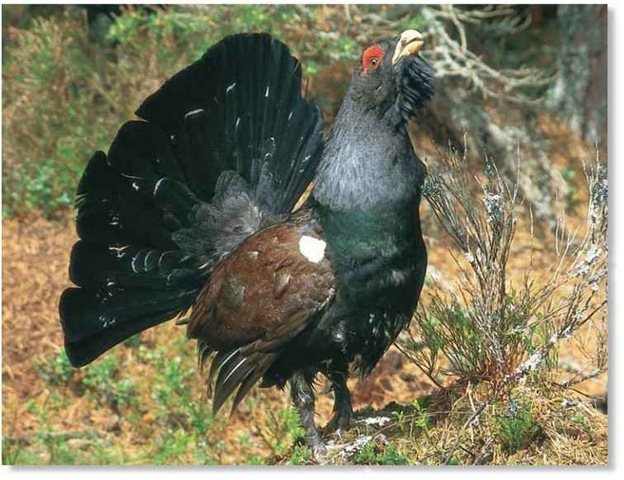ORDER
Galliformes
FAMILY
Tetraonida
GENUS & SPECIES
key features
• Resembling a turkey in flight, this game bird weighs up to 17 lbs.
• The courtship song of the male is one of the most distinctive among birds
• spends most of its life on the ground amid pines and other conifers
where in the world?
Found in northern Europe from scandinavia and eastern Europe to Lake Baikal in Russia; reintroduced into scotland
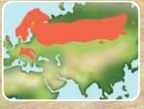
LIFECYCLE
Male capercaillies gather in forest clearings to prepare for a courtship competition, complete with a “wedding” melody; the winner will mate with the most females.
HABITAT
The capercaillie frequents pine and other coniferous forests, especially Scots pine. During nesting, the females seek out boggy areas, where they search for insects to feed their brood. Leks, or courtship territories, require fairly open vegetation. In addition to northern Europe, capercaillies can be found in central Europe plains and the mountainous Balkans. The original populations in Ireland and Scotland were exterminated in the late 1700s when the forests
were destroyed. The capercaillie
was reestablished in the
800s when several
birds were brought
to Scotland from
Sweden.
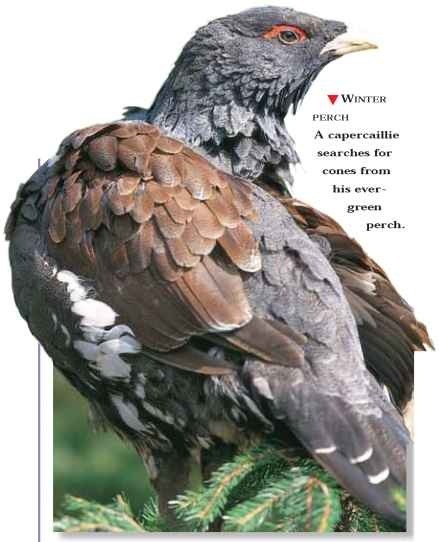
CONSERVATION
The number of capercaillies continues to decrease because of hunting and destruction of habitat, especially courtship areas. The current population is estimated at less than 10,000 pairs. In Slovenia, it is on the Red List of endangered birds.
BEHAVIOR

A Feather duster
Dust bathing helps remove excess oil from feathers.
Lekking, the preparation of an area used for courtship and mating, is a key activity of the capercaillie.The oldest and most aggressive males have the highest social rank they establish the largest territories within the lek and mate with the most females, up to 90% of those in the territory.The mating call of this game bird has been compared to the sound of a rattle followed by a loud pop and ending with a grinding noise.The highly territorial male will protect the lek against other animals and even humans. The capercaillies flight is /pical of game birds: rapid wingbeats, followed by a glide.Takeoff is noisy but flight becomes silent and swift. In the summer, capercaillies travel alone, but by winter, males form large flocks.
The name ‘capercaillie’ is derived from the Gaelic for cock of the woods.
Fences pose a great hazard to the capercaillie; it often flies into them.
In a small forest in the Scottish Highlands, territorial male capercaillies vigorously attacked humans, sheep and a horse in a nearby field, using their wings and beaks.
BREEDING
Capercaillies perform one of the most elaborate courtship rituals of any animal. Males gather together at a lekking site, each with his own territorial portion, to perform for the females.The males stretch their necks, point their bills to the sky and fan their tails; each bird then rustles its wings and jumps high into the air, up to 3′.The courtship song, often called the “wedding- feast” melody, is made up of a variety of sounds, ranging from a noise like fighting cats to a popping cork. Fighting among males often leads to death. For this reason, males do not mate until 3 years of age, when they have attained full adult size and plumage. After mating, hens lay 7-11 pale yellow, speckled eggs in the nest, usually a hollow spot scraped into the ground or among heather. The eggs are covered with pine needles and the female incubates for up to 29 days.The female protects and feeds the nestlings; she will feign injury and lure predators away from the nest and the growing chicks.The young are independent by 3 months of age.
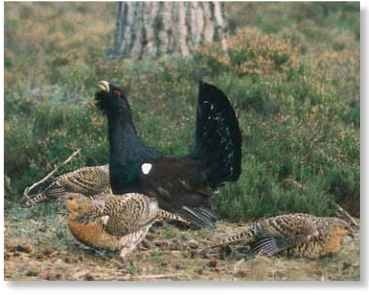
THE MATING GAME
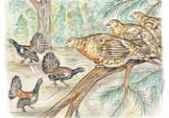
Let the games begin…
Females perch at a strategic location to view males competing for their affections.
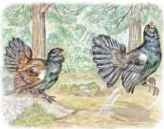
Strutting his stuff…
One male wastes no time as he quickly leaps into the air, singing loudly and puffing out his feathers.
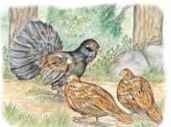
Attention-getter…
As he continues to fan his tail, the efforts of the male pay off when two females begin to approach.
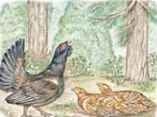
Success
The two crouched females, impressed by the male’s display, call to him and wait for his arrival.
FOOD & FEEDING
Adapting its diet to the season, the capercaillie eats pine needles andcones in the winter and fall, feeding primarily in the trees; ground growth, such as grasses and heather, along with insects, are mainstays in the spring and summer. The capercaillie forages during the day, with peak periods in the early morning and late afternoon; young forage more often than adults. During the spring and summer; the bird walks along, pecking along the ground. But in the winter, with snow covering the ground, the bird prefers foraging in trees, often moving to a new forest just to find the pine needles and cones necessary for subsistence during the cold months.
► Summer search A female forages for leaves in a low-lying bush.
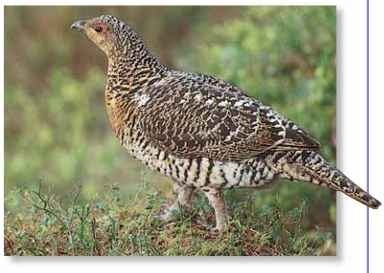
Profile
Western Capercaillie
The male capercaillie is the largest member of the grouse family, easily recognizable by his distinctive olive-green breast and fanned tail.
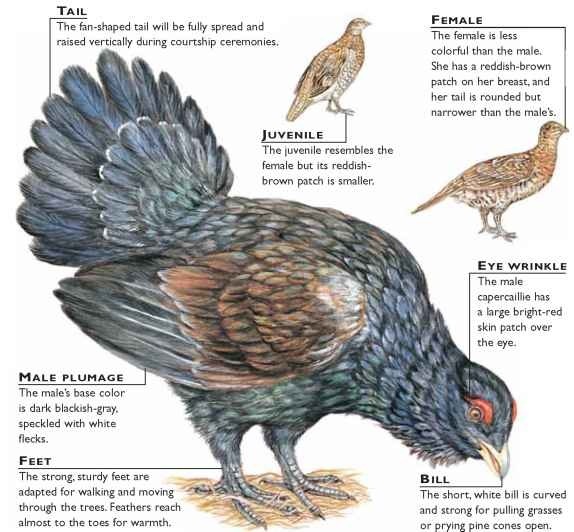
CREATURE COMPARISONS
The blue grouse (Dendragapus obscurus) measures up to 19″ long and is smaller than the western capercaillie.The blue grouse’s upperparts are mostly slate-blue, hence its name.The skin over the blue grouse’s eye is yellow, while the capercaillie has a prominent red marking. Both species have a similar diet; they eat pine needles, plants, berries and seeds. But the blue grouse is found from Alaska south to New Mexico, while the capercaillie resides in northern Europe.
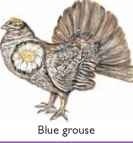
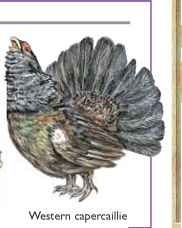
| vital | |
| statistics | |
| Weight | 8-17 lbs. |
| Length | 24-35″ |
| Wingspan | Over 4′ |
| Sexual Maturity | 1-3 years |
| Breeding Season | March-May |
| Number of Eggs | 5-15 |
| Incubation Period | 24-29 days |
| Fledging Period | Unknown!? |
| Breeding Interval | 1 year |
| Typical Diet |
Grass, flowers, berries, fruits, seeds, pine needles; also insects |
| Lifespan | Up to 13.5 years |
Related species
• The western capercaillie is one of 18 species of chickenlike birds in the family Tetraonidae, and is the largest member of the family. Ten species live in North America, including 5 species of grouse, 3 species of ptarmigan and 2 species of prairie chicken. The white-tailed ptarmigan, Lagopus leucurus, is a truly alpine bird, and lives only on the highest slopes of the Cascade and Rocky Mountain ranges.
